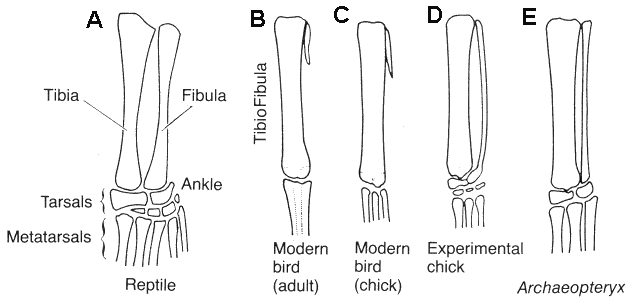
 |
Freethought & Rationalism ArchiveThe archives are read only. |
|
|
#111 | |
|
Veteran Member
Join Date: Jun 2001
Location: Denver, CO, USA
Posts: 9,747
|
Quote:
theyeti |
|
|
|
|
|
#112 | |
|
Contributor
Join Date: Sep 2000
Location: Alibi: ego ipse hinc extermino
Posts: 12,591
|
Quote:
Sure Ed, some junk DNA had a purpose in the past. For instance, it has been shown that birds contain the no-longer-used genes for making full-size fibulas and teeth. By simply inserting a piece of mica between the developing tibia and fibula of a chick embryo, Armand Hampé produced a chicken leg with a complete fibula; this induced the development of separate tarsals too, which normally fuse.  See <a href="http://www.mun.ca/biology/scarr/Hampe_experiment.htm" target="_blank">http://www.mun.ca/biology/scarr/Hampe_experiment.htm</a> By combining the jaw epithelium of chick embryos with the molar mesenchyme of mouse embryos and allowing the tissues to develop, Kollar and Fisher showed that chickens have the genetic information in their genomes to produce teeth: See <a href="http://www.devbio.com/chap06/link0601.shtml" target="_blank">http://www.devbio.com/chap06/link0601.shtml</a> So you’re right, Ed. This unused DNA does seem to have had a purpose in the past in another environment. Oddly though, the environment in question was a bird with a full tibia, separate tarsals and teeth. No modern birds have these... but things like Archaeopteryx did, and so did dromeosaurs. Hmmm. Why do you think that is? Oolon |
|
|
|
|
|
#113 | |||||||
|
Veteran Member
Join Date: Jun 2000
Location: SC
Posts: 5,908
|
Quote:
Quote:
Quote:
Quote:
Quote:
Quote:
[b] Quote:
[ March 18, 2002: Message edited by: Ed ]</p> |
|||||||
|
|
|
|
#114 | ||
|
Veteran Member
Join Date: Jun 2000
Location: SC
Posts: 5,908
|
Quote:
[b] Quote:
|
||
|
|
|
|
#115 |
|
Contributor
Join Date: Sep 2000
Location: Alibi: ego ipse hinc extermino
Posts: 12,591
|
You know, I could have sworn I was trying to converse with Ed here... I was obviously mistaken.
Still, there's all those posts of mine aimed at him as evidence that I was doing so...  Oh of course, silly me, evidence is the one thing creationists can't handle.... Oolon [ March 19, 2002: Message edited by: Oolon Colluphid ]</p> |
|
|
|
|
#116 | ||
|
Contributor
Join Date: Jul 2000
Location: Lebanon, OR, USA
Posts: 16,829
|
Quote:
The ecological-zonation hypothesis fails miserably, because organisms with similar tastes in habitat are found over big ranges of ages -- organisms that are sometimes very slow or stationary. Quote:
Ed seems like he wants to have it both ways -- to advocate that the sedimentary rocks were produced by Noah's Flood, and then to deny that he had ever claimed that when challenged. |
||
|
|
|
|
#117 | |
|
Veteran Member
Join Date: Feb 2001
Location: UK
Posts: 5,815
|
Quote:
|
|
|
|
|
|
#118 |
|
Veteran
Join Date: Aug 2001
Location: Snyder,Texas,USA
Posts: 4,411
|
Re ecological zonation:
Cycads and cypress trees both like swamps, nicht wahr? But cycads are found below cypresses in the geologic column, no es verdad? We know cypresses have knees, but I don't think they have been shown to have feet. They can't run away from a flood any better than a cycad.  [ March 19, 2002: Message edited by: Coragyps ]</p> |
|
|
|
|
#119 | |
|
Veteran Member
Join Date: May 2001
Location: Washington, DC
Posts: 4,140
|
Quote:
|
|
|
|
|
|
#120 | |
|
Veteran Member
Join Date: May 2001
Location: Washington, DC
Posts: 4,140
|
Quote:
Moreover, flowering plants, especially grains, provide the primary food sources of human cultures, and archeological evidence shows this has been the case throughout human history (and prehistory). |
|
|
|
| Thread Tools | Search this Thread |
|